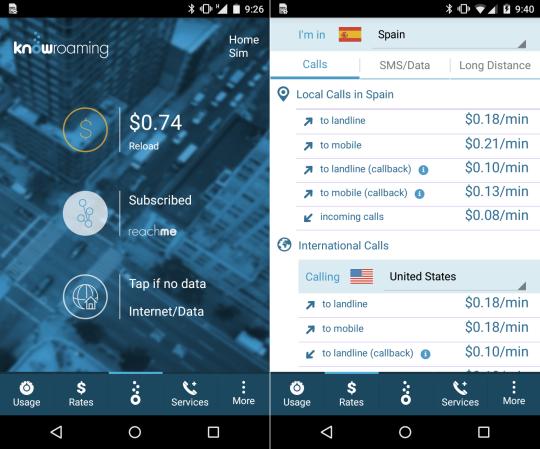You might already know that you can escape ruinous international-roaming costs when traveling by using a prepaid SIM card in your smartphone. It’s easy: All you have to do is get your jet-lagged self off the airplane, find a suitable shop, and pick a SIM from among companies you don’t know after reading labels in a language you can’t read.
Even if you experience no unexplained hang-ups with activating it, you will still have a new phone number, which means no access to the calls and texts coming to your U.S. number.
Or this: There’s a Toronto startup called KnowRoaming that sells a stick-on circuit, which you glue onto your phone’s existing SIM card, that magically gives you discounted roaming overseas.
After hearing friends rave about KnowRoaming, I had to try it for my March trip to Barcelona for the Mobile World Congress. That week, and subsequent research, made two things clear: This is a crafty piece of work. But it only fits some travel scenarios.
Know Its Limits, Know Its Setup
First, you need to start with an unlocked, GSM-capable phone. That includes any AT&T or T-Mobile phone on which you’ve already paid full list price, any GSM phone bought unlocked from a manufacturer, and Sprint and Verizon’s iPhone 5 and 6.
But AT&T phones still under a two-year contract, and T-Mobile phones with pending installment-plan payments, are locked. As for Sprint and Verizon’s other GSM-compatible phones, KnowRoaming doesn’t support them yet.
If you have a qualifying phone, you can take KnowRoaming’s $29.99sticker, remove your existing SIM from your phone, tuck it onto the sticker in an included plastic applicator, and press both together for 30 seconds.
In theory, anyway. I carefully followed the advice in KnowRoaming’s videos, but I saw the sticker peel away as I pushed my SIM card back into my Nexus 4. Uh oh.
Fortunately, I was on my way to the Mobile World Congress trade show. I headed to the KnowRoaming booth, where chief operating officer Dominik Swierad told me the Nexus 4 has “the tightest possible fit.” He got me a new sticker and took care of the issue.
Then I added KnowRoaming’s Android app and a related SIM Toolkit app, and adjusted the phone’s “APN” (Access Point Name) settings according to the instructions. That got the phone online on the first of four networks it used that week.
In Spain and later in Germany, I could pay 15 cents per megabyte of data or opt for a $7.99 unlimited-data daily rate. Texts were free to receive and 14 cents each to send. Incoming calls cost 7 cents a minute, while outgoing calls ran 13 cents a minute to non-U.S. mobile numbers and 10 cents a minute to all others.
(Your costs elsewhere vary. More on that later.)
KnowRoaming set no speed records for me. Downloads only averaged 2.57 Mbps, with uploads at 1.21 Mbps. KnowRoamingdoesn’t support LTE broadband, just the slower 3G standards.
Calls and texts went through fine, although calling a U.S. number involved a cost-saving callback procedure in which I dialed the number, the system hung up, called me back, and then connected me to the number.
One big plus for an international phone: Calls to my regular cell number rang through automatically, courtesy of KnowRoaming’s“ReachMe" option.
That was neat. Not so neat: Having unanswered calls dumped to KnowRoaming’s last-generation voicemail. The company says its Android and iOS apps will soon add a visual-voicemail feature.
The service also gives you a U.K. number and a second U.S. number for free, and you can rent local numbers in 47 other countries.
Texts from home, however, remained inaccessible: KnowRoaming can’t read or forward them.
Once I got back to the U.S., the KnowRoaming sticker went dormant, and my phone just worked at it did before.

Know What You Pay, Know What You Get
Comprehending KnowRoaming’s costs requires a spreadsheet. Outside the 56 countries (41 in Europe) eligible for flat-rate daily data, you can pay from 10 cents to a dollar per megabyte, and calling costs vary about as much.
The math boils down to this: KnowRoaming makes financial sense compared to the $20-plus cost of most prepaid SIMs if one of these conditions applies: You’ll spend three days or less in another country; you can’t miss calls to your home number; you’ll make a lot of calls; or your trip spans multiple countries.
For too many users, unfortunately, this entire discussion is made academic by AT&T’s insistence on locking in-contract phones so they can’t use KnowRoaming’s jiggered SIMs, and the limited compatibility with Sprint and Verizon phones.
Even if your phone is compatible, the international-roaming options of the major carriers may work better. For example, T-Mobile’s free 2G roaming is slow but OK for incidental use and also provides free texting and 20 cents-per-minute calling. Sprint’s new International Value Roaming offers the same pricing in just 15 countries; outside of them, you pay an extortionate $40 for 40 MB.
No question, KnowRoaming can beat all four carriers’ rates for high-speed data overseas: $15 for 100 MB for a day at T-Mobile and Sprint (for “International Value Roaming” countries); $30 for 120 MB atAT&T; $25 for 100 MB at Verizon.
If the KnowRoaming features and pricing make sense for you, it helps to know about it and set it up before you leave on an international trip. It can save you a lot of frustration when trying to get online while you’re in another country.

No comments:
Post a Comment